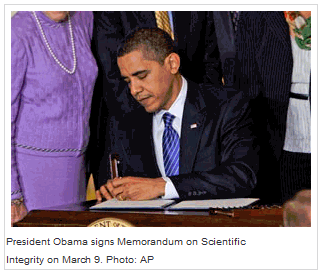|
|
|
|
|
|
|
News & Views item - February 2013 |
![]() Transparency and Integrity at the Intersection of Science and Policy Making.
(February 13, 2013)
Transparency and Integrity at the Intersection of Science and Policy Making.
(February 13, 2013)
 In
this month's mailout from the Union of Concerned Scientists (UCS) Francesca
Grifo, UCS Senior Scientist and Science Policy Fellow, discusses "How
Can We Ensure Transparency and Integrity at the Intersection of Science and
Policy Making" Part of her assessment involves the matter of
getting the Obama administration to implement stricter scientific integrity
policies at governmental agencies and how successful the effort has been now
that the President is into his second term.
In
this month's mailout from the Union of Concerned Scientists (UCS) Francesca
Grifo, UCS Senior Scientist and Science Policy Fellow, discusses "How
Can We Ensure Transparency and Integrity at the Intersection of Science and
Policy Making" Part of her assessment involves the matter of
getting the Obama administration to implement stricter scientific integrity
policies at governmental agencies and how successful the effort has been now
that the President is into his second term.
You may recall that on March 9, 2009 shortly after assuming office, the President issued a memo directing the Office of Science and Technology Policy (OSTP) to develop a plan to restore scientific integrity to federal policymaking. The plan was due by July 9, 2009. It read in part: "Political officials should not suppress or alter scientific or technological findings and conclusions. If scientific and technological information is developed and used by the Federal Government, it should ordinarily be made available to the public. To the extent permitted by law, there should be transparency in the preparation, identification, and use of scientific and technological information in policymaking. The selection of scientists and technology professionals for positions in the Executive Branch should be based on their scientific and technological knowledge, credentials, experience, and integrity." The directive was later amplified* by President Obama in a directive to John Holdren in his capacity as OSTP Director.
Dr Grifo considers that:
We have had a major success in that 23 federal departments, agencies, commissions, and offices drafted and finalized scientific integrity policies, many of which we have posted online. Thatís a big deal and shows some real, concrete progress. As weíve said from the start, what is at stake in this effort is nothing less than the quality of the information upon which our governmentís decisions are based. Sound policy decisions start with the best possible information. When government agencies have strong policies in place, people can see the science used in the decision-making process. That makes it much harder for people to change that science or suppress it.
These policies are designed to ensure that when we bring science into the decision-making process, it is as solid and independent as possible. That means creating mechanisms through which it is safe for scientists in government to speak up when they have questions about problems with the data and that make it possible for them to be heard. In worst-case situations scientists must become whistleblowers, and thankfully we made huge progress with last Novemberís passage of the Whistleblower Protection Enhancement Act. Scientists now have better tools to fight retaliation from federal managers if they expose censorship or other abuses of science.
The implications of these kinds of policies are enormous. Letís say you are
going to your pharmacy to get a prescription filled. You need to have confidence
that, if scientists at the U.S. Food and Drug Administration had any misgivings
about the safety or efficacy of that drug, they were able to speak out and that
the issues were resolved based on science, not politics or profits. Only in that
kind of a policy-making environment can we feel certain that a drug is safe. And
the same holds true when scientists in government have concerns about problems
with food safety, the quality of our air and water, or a host of other issues.
The key is: we need to know about the science, not about somebodyís political
remix of research results.
 Scientific
integrity policies are now in place but they vary in quality and
comprehensiveness. Roughly a third of the agencies and departments broke
significant new ground. Others did the bare minimum.
Scientific
integrity policies are now in place but they vary in quality and
comprehensiveness. Roughly a third of the agencies and departments broke
significant new ground. Others did the bare minimum.
For instance, one key area of scientific integrity involves protecting the right
of last review for scientists. If an agency is publishing a document that
contains data that an agency scientist worked on, that scientist should be able
to look at the final document to make sure the information is accurately
presented. The National Oceanic and Atmospheric Administration (NOAA) and
several other agencies put that into their policies but other agencies did not.
Another important area is an agencyís media policy. It is important for
members of the media to have timely access to agency scientists. To be sure, you
canít run an agency where 500 scientists are each making policy. So, there can
and should be rules about coordination. But we also want a system where our
scientists are free to speak out and where they can speak as private citizens so
we donít infringe on their First Amendment rights.
With all these new policies in place, however, the huge challenge at every agency is implementation: the job of taking these rules and guidelines off the shelf and putting them into action every day. It is not an easy task, and a key piece is leadership. It is vitally important for agency administrators to say they believe in the scientific process, in transparency. Two outgoing agency directors in the first Obama administration, Lisa Jackson at the Environmental Protection Agency and Jane Lubchenco at the National Oceanic Atmospheric Administration, displayed an exemplary commitment on these issues. Each of them spoke over and over about the importance of scientific integrity and they both worked hard to change the culture at their agencies. That kind of leadership is critical.
[Finally,] itís vitally important for people to stay engaged on this issue in this administration and beyond because there is more work to be done. [For example] none of the agencies took on the issue of visitor logs, for instance: it matters who senior aides at an agency meet with in crafting an important piece of policy and there should be transparency.
__________________________________________
*Amplification of original memo.
(a) The selection and retention of candidates for science and technology positions in the Executive Branch should be based on the candidate's knowledge, credentials, experience, and integrity;
(b) Each agency should have appropriate rules and procedures to ensure the integrity of the scientific process within the agency;
(c) When scientific or technological information is considered in policy decisions, the information should be subject to well-established scientific processes, including peer review where appropriate, and each agency should appropriately and accurately reflect that information in complying with and applying relevant statutory standards;
(d) Except for information that is properly restricted from disclosure under procedures established in accordance with statute, regulation, Executive Order, or Presidential Memorandum, each agency should make available to the public the scientific or technological findings or conclusions considered or relied on in policy decisions;
(e) Each agency should have in place procedures to identify and address instances in which the scientific process or the integrity of scientific and technological information may be compromised; and
(f) Each agency should adopt such additional procedures, including any appropriate whistleblower protections, as are necessary to ensure the integrity of scientific and technological information and processes on which the agency relies in its decision-making or otherwise uses or prepares.